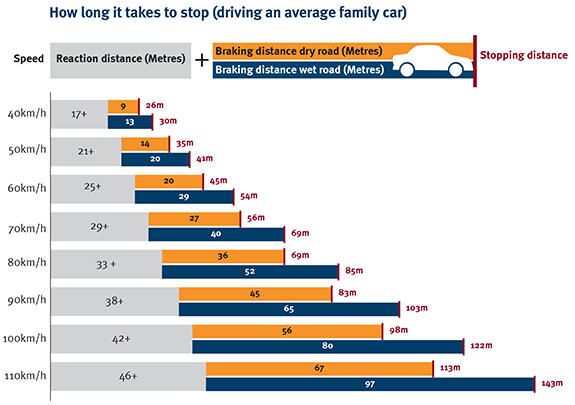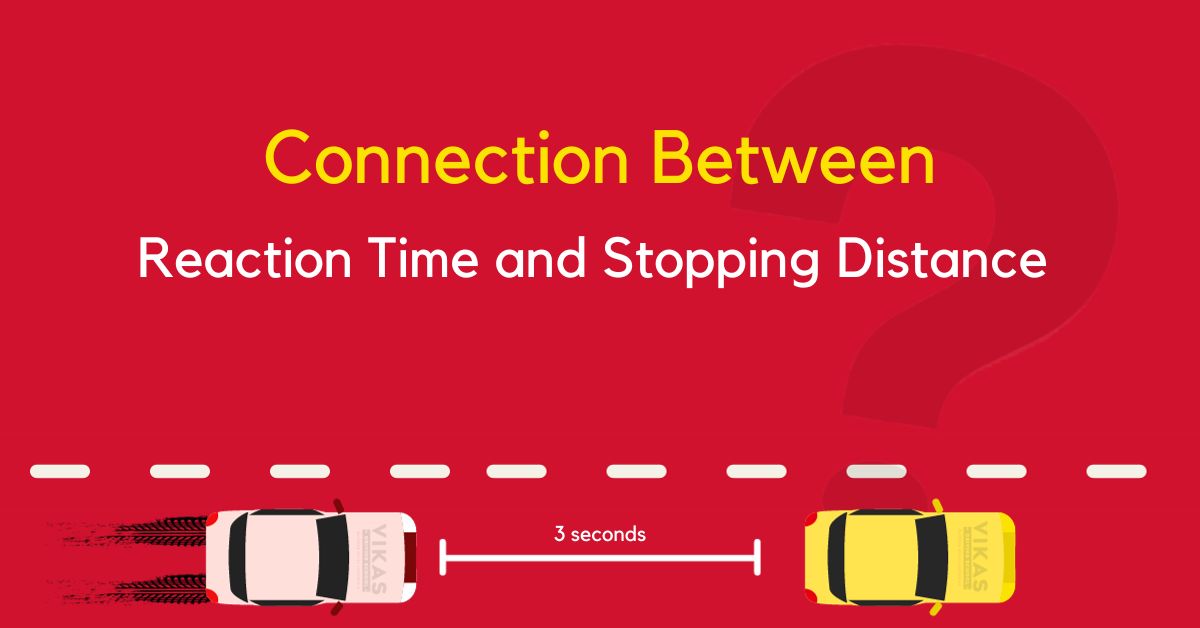When it comes to road safety, knowledge is power. Two critical factors that have a significant impact on road safety are reaction time and stopping distance. By examining these factors, we can gain insight into how to drive safely and reduce the risk of collisions.
Reaction time refers to the time it takes for a driver to perceive a hazard and react to it. The faster the reaction time, the better chance a driver has of avoiding accidents. Stopping distance, on the other hand, is the distance a vehicle travels from the moment the driver applies the brakes until the vehicle comes to a complete stop. It consists of both the thinking distance and the braking distance.
In this blog, we will learn about the connection between reaction time and stopping distance and explore how they contribute to road safety. We will examine the factors that influence these two crucial elements and provide tips on how to improve them.
Understanding Reaction Time
Reaction time is a vital component of safe driving. It is the time it takes for a driver to perceive a hazard and react to it. The faster a driver can react, the better chance they have of avoiding accidents. Reaction time can be influenced by various factors, including human factors, vehicle factors, and tire conditions.
Human Factors
Human factors play a significant role in reaction time. Factors such as age, fatigue, distractions, and impairment can all affect a driver’s ability to react quickly. Younger drivers tend to have faster reaction times compared to older drivers. Fatigue can slow down reaction time, impairing a driver’s ability to respond to hazards effectively. Distractions, such as using a mobile phone or eating while driving, can also increase reaction time as attention is divided. Additionally, impairment from alcohol, drugs, or certain medications can severely impact reaction time.
Vehicle Factors
The condition of the vehicle can also influence reaction time. A well-maintained vehicle with properly functioning brakes, tires, and suspension can help reduce reaction time. On the other hand, a vehicle with faulty brakes or worn-out tires may increase reaction time as it takes longer for the driver to stop the vehicle.
Tire Condition
The condition of the tires directly affects reaction time. Properly inflated and well-maintained tires provide better traction and grip on the road, allowing quicker stops. Worn-out or underinflated tires, on the other hand, reduce the vehicle’s ability to stop quickly, increasing reaction time.
The link between reaction time and stopping distance
Reaction time and stopping distance are closely related. The time it takes for a driver to react to a hazard directly impacts the distance traveled before the vehicle comes to a complete stop. The longer the reaction time, the greater the stopping distance.
To illustrate this relationship, let’s consider a scenario where two drivers, Driver A and Driver B, encounter the same hazard. Driver A has a reaction time of 1 second, while Driver B has a reaction time of 2 seconds. Assuming both vehicles are traveling at the same speed, Driver A will be able to start braking earlier, reducing their stopping distance compared to Driver B, who reacts later.
It is essential to understand that even a slight decrease in reaction time can lead to a significant reduction in stopping distance. This reduction can be the difference between a close call and a collision. Therefore, improving reaction time is crucial for enhancing road safety.
The science behind stopping distance
Stopping distance is the distance a vehicle travels from the moment the driver applies the brakes until the vehicle comes to a complete stop. It consists of two components: thinking distance and braking distance.
Thinking Distance
Thinking distance is the distance traveled by the vehicle during the driver’s reaction time. It is the distance covered from the moment the driver perceives a hazard until they start applying the brakes. Thinking distance is influenced by reaction time and the speed at which the vehicle is traveling. The faster the vehicle’s speed or the longer the reaction time, the greater the thinking distance.
Braking Distance
Braking distance is the distance traveled by the vehicle while the brakes are applied. It is determined by factors such as the vehicle’s speed, weight, and the effectiveness of the brake system. The faster the vehicle’s speed, the longer the braking distance. Additionally, a heavier vehicle requires a longer braking distance to come to a complete stop. The effectiveness of the brake system, including the condition of the brake pads and the brake fluid, also affects braking distance.
Calculating stopping distance
To calculate stopping distance, we need to consider both the thinking distance and the braking distance. The total stopping distance can be calculated using the following formula:
Total Stopping Distance = Thinking Distance + Braking Distance
Thinking distance can be calculated by multiplying the reaction time by the vehicle’s speed. The braking distance can be calculated using various formulas that take into account the vehicle’s speed and other factors such as the coefficient of friction between the tires and the road.

It is important to note that stopping distances can vary depending on road conditions, such as wet or icy surfaces, as well as other factors like tire grip and vehicle load. These factors can increase the total stopping distance, emphasizing the need for drivers to adjust their driving behavior accordingly.
Tips for improving reaction time and reducing stopping distance
Improving reaction time and reducing stopping distance can significantly enhance road safety. Here are some tips to help drivers improve their reaction time and reduce their stopping distance:
- Stay focused and avoid distractions while driving. Keep your attention on the road and avoid activities that divert your attention, such as using your phone or eating.
- Maintain a safe following distance. Keeping a safe distance between your vehicle and the one in front allows for more time to react and reduces the need for sudden and abrupt braking.
- Avoid tailgating. Following other vehicles too closely reduces your reaction time and increases the risk of a collision. Maintain a safe distance to ensure you have enough time to react if the vehicle in front suddenly stops.
- Regularly maintain your vehicle. Ensure your brakes, tires, and suspension are in good condition. Regular inspections and maintenance can help reduce reaction time and improve overall stopping distance.
- Practice defensive driving techniques. Anticipating potential hazards and constantly scanning the road ahead can give you more time to react and reduce your stopping distance.
- Avoid driving under the influence of alcohol, drugs, or certain medications. Impairment can significantly slow down reaction time and increase the risk of accidents.
The Role of Technology in Road Safety
Technological advancements have played a significant role in improving road safety. Various safety features in modern vehicles can assist drivers in reducing reaction time and stopping distance. These features include:
- Anti-lock braking systems (ABS): ABS prevents the wheels from locking up during hard braking, allowing the driver to maintain control of the vehicle and reduce stopping distance.
- Electronic stability control (ESC): ESC helps to maintain vehicle stability during sudden maneuvers or loss of control, reducing the risk of skidding and improving overall control of the vehicle.
- Forward collision warning (FCW) systems: FCW systems use sensors and cameras to detect potential collisions and provide warnings to the driver, allowing for quicker reaction time.
- Autonomous emergency braking (AEB): AEB systems can automatically apply the brakes in emergencies, significantly reducing stopping distance and potentially avoiding a collision altogether.
These technological advancements, combined with driver awareness and responsible driving habits, contribute to making the roads safer for everyone.
Safe driving habits to prevent accidents
In addition to understanding the science behind reaction time and stopping distance, adopting safe driving habits is crucial for preventing accidents. Here are some key safe driving habits to keep in mind:
- Obey traffic laws and speed limits. Adhering to traffic regulations ensures a safer driving environment for everyone on the road.
- Always wear seat belts. Seat belts significantly reduce the risk of injury or death in the event of a collision.
- Avoid aggressive driving behaviors. Aggressive driving, such as excessive speeding, tailgating, and frequent lane changes, increases the likelihood of accidents.
- Use turn signals correctly. Signaling your intentions allows other drivers to anticipate your actions, reducing the risk of collisions.
- Stay alert and avoid drowsy driving. Fatigue can impair judgment and reaction time. If you are feeling tired, take a break or find a safe place to rest.
- Practice defensive driving. Anticipate potential hazards, be aware of your surroundings, and adjust your driving accordingly to reduce the risk of accidents.
By adopting these safe driving habits and understanding the science behind reaction time and stopping distance, we can all contribute to creating a safer road environment for ourselves and others.
Conclusion:
Reaction time and stopping distance play significant roles in preventing accidents and reducing the severity of collisions. By understanding the factors that influence these elements and implementing tips to improve reaction time and reduce stopping distance, drivers can enhance their driving skills and easily pass their Vic road driving test.
Additionally, technological advancements in vehicle safety systems further support safe driving practices. Features such as ABS, ESC, FCW, and AEB support drivers in critical situations, helping reduce reaction time and stopping distance.
However, it is important to remember that technology alone is not enough. Drivers must also adopt safe driving habits, obey traffic laws, and stay focused on the road. By combining knowledge, responsible driving behavior, and technological advancements, we can all work towards making the roads safer for everyone. It is also recommended to take driving lessons from a good Driving School in your area to be a confident and responsible driver on the road.

